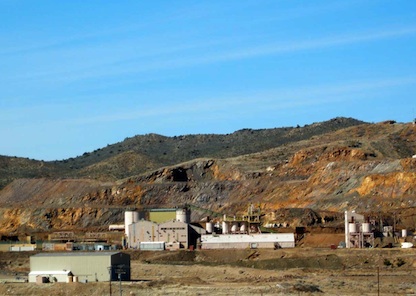Troubled mine holds hope for U.S. rare earth industry
China currently controls 97 percent of the world’s rare earth production. The Mountain Pass Mine could change that -- if it can overcome serious environmental concerns.
Feb 04, 2021120.1K Shares2.2M Views
The Mountain Pass Mine in California, which closed in 2002, is considered the country's best hope to combat China's trade dominance in rare earth elements. (WikiCommons)
In 1949, two geologists found what they suspected to be a massive uranium deposit in the desert of southeastern California, about an hour’s drive from Las Vegas. A cache of uranium would have been an incredibly lucrative find, but the geologists were disappointed when further testing revealed the area to be full of deposits of rare earth elements.
[Environment1] Rare earth elements, also called rare earth minerals, were thought to be virtually worthless. For the most part, the REEs, obscure elements with names like Promethium and Europium, had no practical use.
But the geologists saw potential in REEs and convinced the Molybdenum Corporation of America to buy the mining rights to the 222acres of land that would later become known as the Mountain Pass Mine. The decision to mine that land, once considered a gamble, is now paying off in a big, big way.
During the last 60 years, the company, which became known as Molycorp, developed thousands of uses for REEs, jump-starting a worldwide race to mine the minerals and landing the company squarely in the middle of a trade face-off between the United States and China.
Amid new fears about the United States’ dependence on China for its REEs, politicians are callingfor the U.S. to develop its own REE resources. Attention has shifted back to Molycorp and its Mountain Pass Mine, considered by many experts to be the country’s best hope to compete with China. But the Mountain Pass Mine closed down in 2002 amid a series of waste water spills that dumped radioactive materials all over Mountain Pass. Now, the company, which is planning to reopen the mine amid big claims about its potential to meet the country’s REE demand, must prove that it can clean up its act.
Through the early 1970s, Mountain Pass was the world’s largest REE supplier. “They were unchallenged in the world as suppliers of this material until the Chinese discovered that they had a large amount of this stuff as a byproduct of iron deposits,” said Bill Bird, president of Medallion Resources, an REE exploration company.
But China soon began to realize its REE potential. In the 1980s and 1990s, China doubled down on a strategic effort to become the world’s REE superpower. In 1992, Deng Xiaoping, head of the country’s Communist Party, famously said, “The Middle East has oil, China has rare earths.”
The effort paid off. China now corners the market on REEs, controlling an estimated 97 percent of the world’s production. And the market is huge — and growing. REEs are used in everyday consumer goods like DVD players, cell phones and televisions; they are found in satellite communication devices and the military’s smart bombs; and they are key components of clean energy technology like wind turbines and electric vehicles.
Trade experts have long raised concernsabout China’s control over the world’s REE supply. Those concerns reached a fever pitch last week when The New York Times reported that China was blocking shipmentsof REEs to the United States. The report came just days after the Obama administration announced it would investigatethe country’s green tech trade practices.
By the mid-1990s, the Mountain Pass Mine was feeling the weight of China’s REE exploits. China had developed its own resources and was exporting REEs at prices that the company couldn’t match. “The Chinese started producing rare earth elements, and China being what it is, they were able to produce them very cheaply,” Bird said.
On top of that, the Mountain Pass Mine came under fire from state and federal regulators for a series of mine waste spills. Over the course of ten years, thousands of gallons of waste from the Mountain Pass Mine spilled from holding ponds and waste pipelines, according to reports. The waste included thorium, a radioactive byproduct of REE mining.
Mining at Mountain Pass stopped soon after the spills came to light. Industry sources say Union Oil of California, which bought Molycorp in 1977, couldn’t afford to comply with environmental rules and felt that it couldn’t compete with China. In 2002, the company did not renew a permit to store tailing, the uranium and thorium waste that is a byproduct of REE mining, and the Mountain Pass Mine shut down.
“The economics wasn’t there because China had ramped up its production and was aggressively mining,” said Molycorp spokesman Jim Sims.
One industry veteran said the spill will cost oil giant Chevron — which bought Molycorp from Union Oil of California in 2005 — an estimated $185 million to clean up. The official called the mine’s poor environmental record “legendary.”
Confronted with China’s REE dominance and questions about its environmental record, Molycorp worked during the next several years to reopen the mine and develop a cheaper and more efficient way to remove and isolate REEs. The chemical separation process, which extracts the valuable REEs, is the most expensive and environmentally risky part of REE mining.
With a new and cheaper separation process, Molycorp, which became the sole owner of the mine in 2008, is hoping to break ground on the new REE separation facility in January. The “near-zero emissions” facility will recycle the waste water produced from the process, as well as many of the chemicals necessary to separate out the REEs, Sims said.
“The new facility incorporating these new environmental technologies will produce rare earths at a cost-per-pound that is one half of the Chinese,” Sims said, adding that the company hopes to begin mining again at Mountain Pass in 2012. Sims says the mine will produce 20,000 tons of REE-equivalent each year, more than the current U.S. demand of between 15,000 and 18,000 tons per year.
“We’ll be in a position of virtual independence,” Sims said, though he noted that the company will also sell REEs overseas.
But the industry veteran, who requested anonymity, raised questions about whether Molycorp could meet its timeline for beginning operations. “They’ve been saying it’s six months off since 2007,” the industry veteran says.
Given the recent reports about China, there is more pressure than ever on the United States to develop home-grown REE resources. Experts say U.S. rare earth demand is certain to balloon in the coming years, as plug-in hybrid electric vehicles become cheaper and wind turbines begin to pop up all over the country. One turbine can require as much as a ton of REEs.
“We’re becoming dependent on these things for the economy to keep going,” said Jim Hedrick, an REE consultant. “As people are learning more about the rare earths, more and more chemists and biologists are finding new uses for them.”
Hedrick believes the U.S. is too reliant on rare earths to not develop a domestic REE industry. “If you pull rare earths out of the equation, then you’ll cause a lot of disruption,” he said.
Despite Molycorp’s goals, experts suggest that it will take many years to develop a U.S. REE industry. Yaron Vorona, executive director of the Institute for the Analysis of Global Security’s Technology and Rare Earth Metals Center, cited an April 2010 Government Accountability Office report that says it could take 15 years to develop a U.S. rare earth industry.
Vorona says the U.S. has a lack of scientific knowledge about REEs because most scientists went to China to continue their work on the minerals decades ago. “If the mines that are being planned were all to come online tomorrow that would be fantastic, but there would be nobody to run them,” Vorona said, noting that China has 100,000 rare earth scientists.
He also said that chemical separation of REEs is often very difficult to perfect. “It’s a very long and involved process,” he says. “That’s one of the biggest risks. It can take dozens, hundreds of steps to separate the rare earths.”

Hajra Shannon
Reviewer
Hajra Shannona is a highly experienced journalist with over 9 years of expertise in news writing, investigative reporting, and political analysis.
She holds a Bachelor's degree in Journalism from Columbia University and has contributed to reputable publications focusing on global affairs, human rights, and environmental sustainability.
Hajra's authoritative voice and trustworthy reporting reflect her commitment to delivering insightful news content.
Beyond journalism, she enjoys exploring new cultures through travel and pursuing outdoor photography
Latest Articles
Popular Articles
